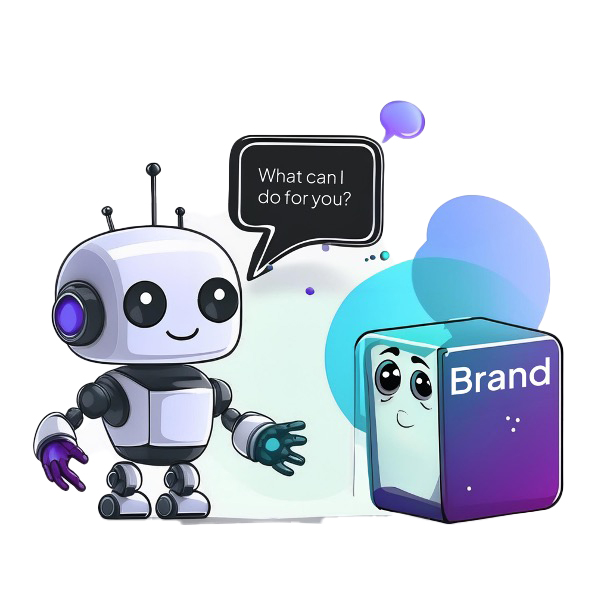Following its initial impact, AI continues to revolutionise the way we work, and its influence on marketing, in particular, is becoming impossible to ignore. In a world where differentiation is key, understanding how AI can shape and enhance your brand is more important than ever.
AI empowers marketing teams with significant advantages and cost savings. However, these benefits aren’t without their challenges – data privacy, implementation, skill gaps, and ethical considerations are just a few of the obstacles that marketers must overcome.
Firsthand here at onebite, we know how brilliant AI can be at automating repetitive tasks and analysing data to better predict customer behaviour. And while AI has become essential when it comes to content analysis, ideation and generation, one of its key, often understated, uses is in amplifying a brand’s identity.
As marketeers, we can’t overstate the importance of brand. In this article, we’re excited to explore the role of AI in supporting your brand management strategies.
What is “brand”? How do you create a brand?
There are many views on what brand is. At onebite, we see it as the combination of associations and identity held in the mind of your customer, encompassing everything from identity and reputation to perceptions of value and market positioning. When we talk about brand, we refer to this broader perspective. It’s about how you present yourself, how your team communicates your brand, and how it is perceived by the world.
In the current market, differentiating yourself is challenging, especially when you offer similar products or services as your competitors. Brand is what makes you stand out. Your brand is the reason customers choose to buy from you; it’s what sets you apart in the marketplace.
What makes a brand solid?
A brand is a promise where you know what you’re going to get. Good branding doesn’t happen overnight. It takes time and investment to build brands that resonate, are remembered, and most importantly, become trusted.
A solid brand reflects clear company values and goals, value proposition to a target audience, and a well-defined perception of how the brand wants to be seen. These elements involve various activities in the brand lifecycle. So, how can AI aid these activities?
Some of the most popular and widely adopted tools focus on generating content that positions the brand and engages your audience across various formats and channels.This article suggests there are at least 16 types of content marketing. At this point in time, we can guarantee you will find multiple AI tools to help you create each type of content on this list.
One of the biggest misconceptions about brand is that it’s solely about logos and graphic assets. And since AI came onto the scene, this misconception has become even more evident as the tools to create assets are more available and the intelligence to create them can lead to results that really expose the problems of an immature brand.
Of course, AI can quickly generate ideas, logos and variations of them. It can provide full branded kits for print or social media. It can generate icons and graphics that match your chosen style. It can also aid the process of reshaping and customising assets for various platforms, and even provide feedback on the generated content.
Generative AI focuses on understanding patterns and structure in data and using that to create new data that looks like it. So, if you think of this in the context of your brand, the quality of the output depends on the data you input and how well you describe your requirements.
AI will literally interpret what you communicate. It won’t have an awareness of symbolism, current trends and metaphors. It can be disconnected from your reality, and it can incorporate design elements that are generic and could make the results less memorable, putting you at a disadvantage against competitors.  “So, tell me brand. What can I do for you?” This illustration of a little robot representing AI, and a character representing brand, was generated with Adobe Firefly. We had to edit and refine the prompts to achieve the image we wanted.
“So, tell me brand. What can I do for you?” This illustration of a little robot representing AI, and a character representing brand, was generated with Adobe Firefly. We had to edit and refine the prompts to achieve the image we wanted.
The success of generative AI to create your assets lies on the solidity of your brand. Things you can’t expect from generative AI include knowing your unique value proposition and personality. It won’t define your identity and it certainly won’t deliver your strategy. All these aspects are important in creating a solid brand.
We’ve all seen headlines where AI has been used improperly or gone wrong, causing damage to some brands. A notable incident earlier this year involved Air Canada’s chatbot. The airline’s chatbot, allegedly “responsible for its own actions,” provided incorrect information to a customer about bereavement fares, misleading him into buying a full-price ticket. This story highlights the importance of trust in any AI-driven marketing strategy. As AI continues to permeate various aspects of our lives, genuine human interactions and authentic communication become increasingly important.
There are powerful AI tools to aid the process of creating your brand and making it strong over time. Activities such as market research, competitor analysis, intelligent insights into the market and much more. Although human-to-human discussion and analysis are essential, AI can truly enhance the strategic side of things. We won’t focus on those here, but we will dive into them in a future post.
How to know if your brand is solid enough to work with AI?
- Your brand has been through the process of being consciously defined, reflecting your company values and offering a clear proposition that differentiates it from your competitors.
- Your brand demonstrates maturity through consistency across all touchpoints and formats. This evolution can also be evident through simplicity, your brand has evolved to lose what is not needed.
- Your brand is already capable of establishing emotional connection, of being memorable and of generating trust.
- There is a human capable of discerning if a piece of content or asset aligns with your brand. This instant clarity indicates that the brand has been well-developed, providing sufficient evidence to train the AI.
- There is enough raw material that is consistent and represents various formats and expressions of your brand effectively. This will train and feed the AI effectively.
Brand Asset Management tools
The use of Brand Asset Management tools is a great idea if your brand is solid. AI powered brand asset management tools leverage artificial intelligence and machine learning to streamline the organisation, governance, and utilisation of a company’s brand assets.
What can they do for you?
Generate content – Including text, sound, images, videos.
Enforce brand guidelines – AI can analyse your brand assets ensuring new assets comply with your guidelines and are consistent. It can also automatically identify and update visual elements that are perhaps outdated.
Aid workflows – AI can customise your assets so that they are the right specifications for distributing.
Organise your assets – AI can centralise, tag and categorise assets, giving you more control.
Personalisation – It can customise assets depending on user data to align with your audience better.
Insights – AI can help you track the usage and engagement of your assets.
Prompt libraries
An AI prompt is a mode of interaction between a human and a large language model that lets the model generate the intended output. According to this article, there are 40 specific types of AI prompts that are useful for marketing teams. Some of these include:
- Content creation for blog ideas and drafting
- Market research to analyse customer feedback and customer profiling
- Campaign optimisation to optimise ads
- Email subject lines
- Content personalisation
- SEO and analytics
- Visual content
Learning to create effective prompts is a key skill to make the most of the AI tools available to marketers. It involves a combination of abilities related to language structure, the use of empathy and understanding of the context, topics at hand and the reality you live in. It is a path to create something that, in a way, already exists in your mind.
The quality and specificity of your input directly influence the output. This example illustrates how progressively detailed prompts lead to more accurate and refined results from the AI image generator.
The science behind prompts is moving rapidly along with the development of AI tools. HubSpot’s article explores examples of prompts relevant to marketers and is well worth checking out.
At onebite, we started using prompts to produce results that can feed our research and our own content generation. Our experience tells us that many elements play a part in creating content and assets that really convey what you want to say. Once again, we find that for brand, the success lies in how your brand is created and how well you can communicate it to the AI you work with. Still, in many cases we find that it would have been better to do it all from scratch. This may be due to the current state of AI tools and their adoption, which might improve in the near future.
We find that prompts need to be clear, relevant, detailed and complex enough by incorporating existing knowledge and understanding to avoid ambiguous results. Often to get one type of result, you must provide clues that come in various formats to effectively communicate your point. Also, you need to be aware of preconceptions and biases. At the end of the day, AI learns from what has been created to date. Although this aspect is sometimes perceived as limiting for creativity, when used well, it is a great tool for creation where human awareness, knowledge and critical thinking is perhaps the biggest piece of the puzzle.
Remember, your brand encompasses so much more than just your logo – it represents the essence of your identity, values, and market positioning. While AI can be a valuable tool for content generation across various formats and channels, it has limitations when it comes to grasping symbolism, trends, and metaphors. Therefore, the effectiveness of AI in creating brand assets is largely dependent on the strength and solidity of your existing brand. That said, there are many ways to maximise the benefits of AI. As we’ve covered in this article, consider using resources such as Brand Asset Management systems and prompt libraries to assist with creating content and brand assets. These tools can help ensure that AI-generated content aligns with your brand’s core values and messaging.

Marcela Bohórquez, Senior Developer
Marcela, Senior Developer at onebite with over 25 years of experience in the digital media world. She holds a Bachelor of Science in Systems and Computing Engineering from the University of the Andes and a Master of Arts in Digital Media from London Metropolitan University.
Throughout her career, Marcela has developed a wide range of projects, including websites, web applications, interactive experiences, video and animation. She specialises in the intersection of creativity and technology and she is equally passionate about tackling technical challenges and creative ones, always striving to communicate and engage effectively through the strategic use of digital tools and platforms. She also shares her experiences, knowledge and research through collaborating in the onebite’s maketing blog. She is interested in how technology evolves and shapes our world.




